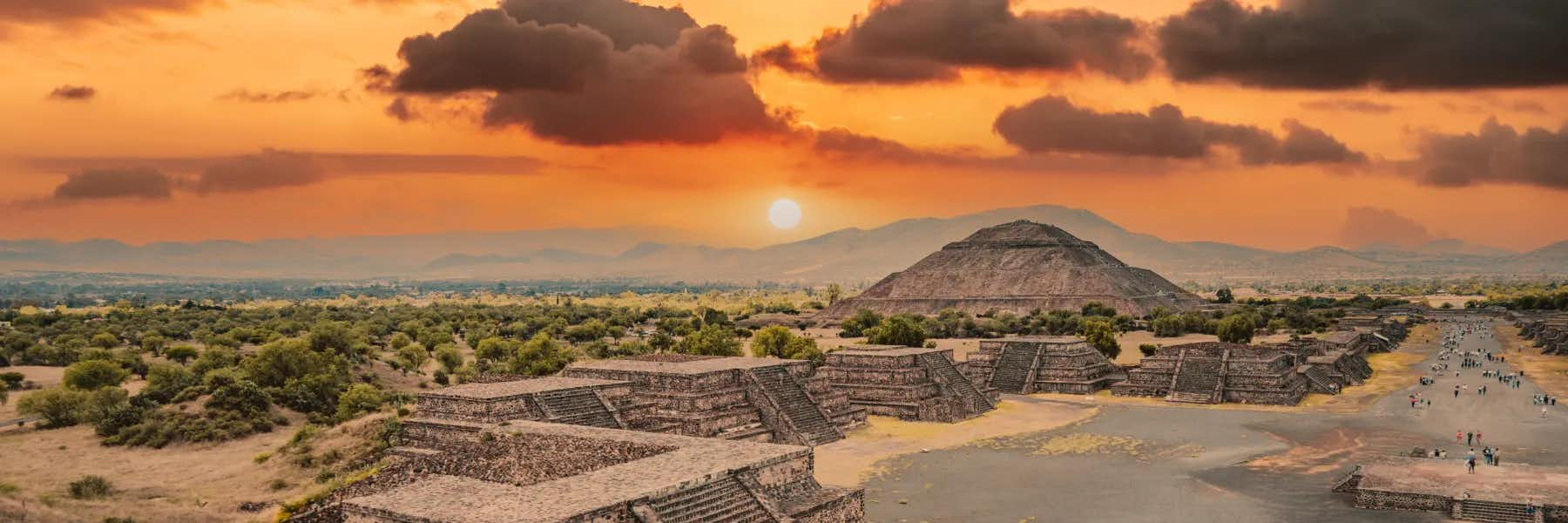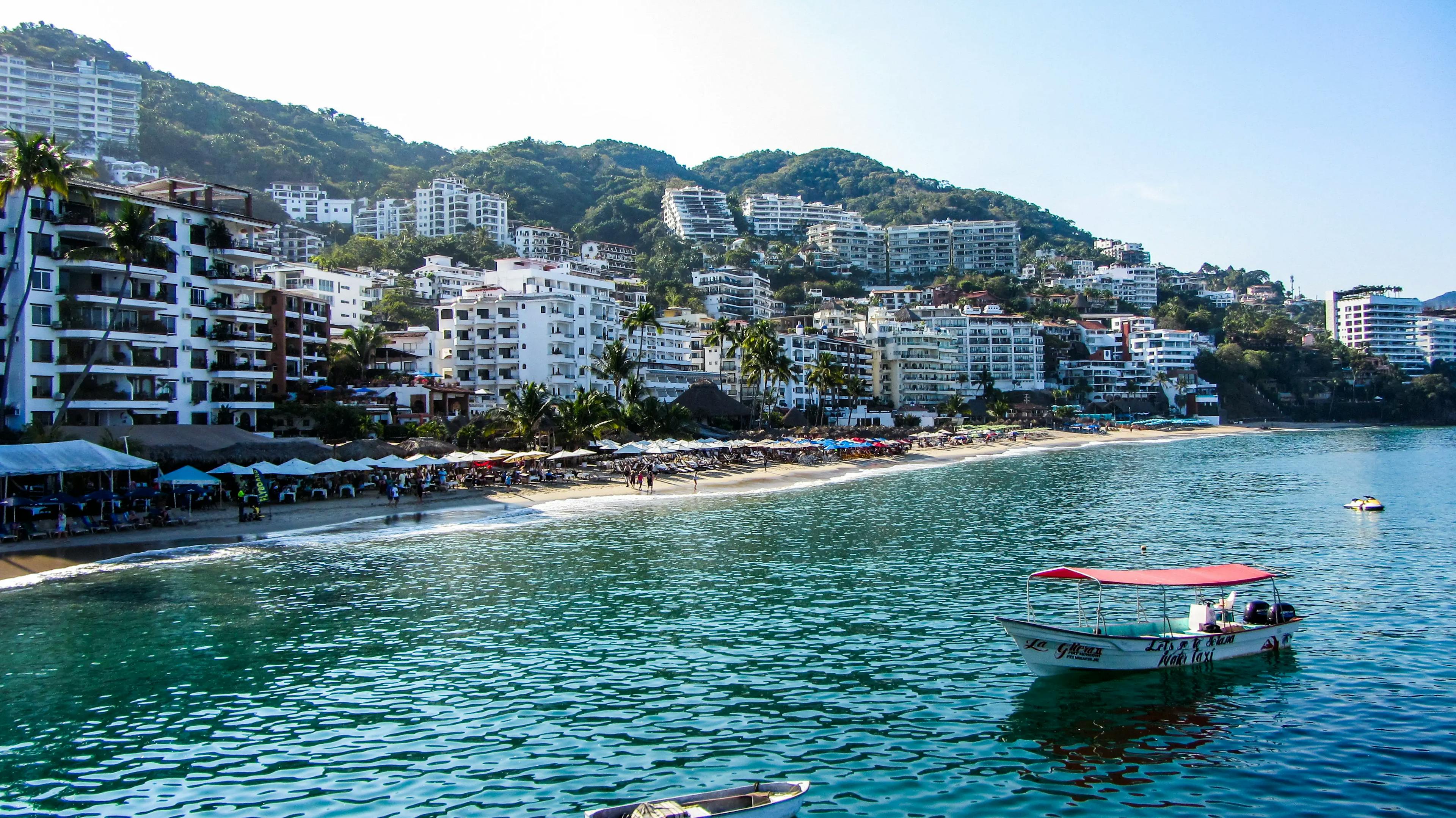Nearly 2 million U.S. citizens have pulled up stakes and moved to Mexico for a better life; it’s the most popular country in the world for Americans who choose to live abroad.
Mexico is relaxed and friendly. The highways are good, the healthcare is excellent and affordable, and the food is terrific. The immigration system is surprisingly uncomplicated, and long-term living in Mexico is possible for many retirees and remote workers—no lawyers or agents are needed.
Mexico has something for everyone: funky towns and classy resorts, hundreds of beaches, world class diving and snorkeling, lush jungles, high-altitude deserts, snow-capped mountains, and beautiful Spanish colonial cities. Whether you like a warm climate with a constant sea breeze, a hot and dry semi-arid or desert climate, or you want to be somewhere cool enough that you’ll need to wear a jacket in the evenings year-round, Mexico offers unlimited choices.
Get Your Free Mexico Report Today!
Get Your Free Mexico Report Today!
Learn more about Mexico and other countries in our daily postcard e-letter. Simply enter your email address below and we’ll send you a free special report – Mexico: The Perfect Close-to-Home Retirement Haven.

By submitting your email address, you will receive a free subscription to IL Postcards, Overseas Dream Home, The Untourist Daily and special offers from International Living and our affiliates. You can unsubscribe at any time, and we encourage you to read more about our Privacy Policy.
Getting the Right Visa for Mexico
If you’ve never visited Mexico, get a tourist visa and take a scouting trip first. Tourist visas may be valid for up to six months, but that length of stay isn’t automatic. If you want to guarantee that you can remain in the country for a full six months, apply for your visa at a Mexican consulate in the U.S.
The government is discouraging the practice of visa runs, but if you want to stay for longer, Mexico has made it relatively easy to get visas that are valid for more than six months.
The application process for temporary or permanent residency begins at a Mexican consulate in your home country. The consulate will provide their requirements and instruct you on which forms you’ll need to complete; all forms are in Spanish. Financial requirements will vary somewhat from one consulate to the next.
Temporary Residency visas are valid for a period of six months to a maximum of four years. You’ll need to provide proof of having a monthly income of $2,400 to $2,700 over the past six months or a savings or investment account balance of $45,000 per month over the past year.
If you are applying for permanent residency, you’ll need to provide proof of a monthly income of $7,100 over the past six months or a savings balance of at least $180,000 every month for the past year. Permanent residency never expires and is the first step towards Mexican citizenship.
Get Your Free Mexico Report Today!
Get Your Free Mexico Report Today!
Learn more about Mexico and other countries in our daily postcard e-letter. Simply enter your email address below and we’ll send you a free special report – Mexico: The Perfect Close-to-Home Retirement Haven.

By submitting your email address, you will receive a free subscription to IL Postcards, Overseas Dream Home, The Untourist Daily and special offers from International Living and our affiliates. You can unsubscribe at any time, and we encourage you to read more about our Privacy Policy.
It’s also possible to get a temporary resident visa if you invest at least $100,000 in a business; if you invest at least $200,000, you’ll be eligible for a permanent resident visa and a fast-track to citizenship.
Bring all your required documentation to the consulate on the date of your appointment. You’ll be interviewed by a Consular Officer, who will verify your eligibility and ask you a few questions about why you want to move to Mexico. If you are applying with a family member, each applicant will need to make a separate appointment and will need to bring proof of their income and eligibility.
Once approved, you’ll pay a $48 fee at the consulate and receive a special visa valid for up to 180 days.
You’ll need to report to a Department of Immigration office in Mexico before the visa expires and within 30 days of your arrival. Bring all your paperwork to the appointment, including proof of your address in Mexico. The price for a one-year temporary residency card is 4,739 pesos ($229); the fee for permanent residency is 5,776 pesos ($279).
Applying for residency in Mexico does not require any documents to be notarized or apostilled. There are no police or FBI checks, no medical clearances or vaccinations, or any other difficult to obtain documentation. Your biggest expense will probably be making two copies of six to 12 months of bank statements.
Get Your Free Mexico Report Today!
Get Your Free Mexico Report Today!
Learn more about Mexico and other countries in our daily postcard e-letter. Simply enter your email address below and we’ll send you a free special report – Mexico: The Perfect Close-to-Home Retirement Haven.

By submitting your email address, you will receive a free subscription to IL Postcards, Overseas Dream Home, The Untourist Daily and special offers from International Living and our affiliates. You can unsubscribe at any time, and we encourage you to read more about our Privacy Policy.
Finding Your New Home in Mexico
When you decide to move to Mexico, one of your more difficult decisions may be where to live. Expat havens can be found along both the Pacific and Caribbean coasts, and throughout most of the country’s interior.
Initially, you may want to consider short-term housing and rent a hotel room or serviced apartment through a booking company like Airbnb.
Facebook’s numerous expat groups are a good source for finding both short and long-term accommodation in expat neighborhoods. You’ll find which expat-friendly realtors can show you properties of interest, and they will help negotiate the terms of your lease, too.
When renting, many property owners will ask foreigners for either a fiador (a co-signer who owns property and lives in Mexico) or a Póliza Jurídica, which requires registering the lease with the police; these registered documents protect the rights of both the lessor and the lessee. Realtors, property managers, and attorneys can help with either process. The Póliza Jurídica usually costs about 35% of the first month’s rent. Some property owners may also insist that you have renter’s insurance. Be prepared to show proof of one year’s income or economic solvency and pay a one-month deposit in addition to the full first month’s rent.
Bringing Your Pets to Mexico
You can import up to two pets per person into Mexico. If you’re traveling from either the U.S. or Canada, you do not need to provide a veterinary certificate to bring your pet to Mexico. However, if you’re entering from any other country, you’ll need a certificate dated within 15 days of your departure that includes proof that your pet has been vaccinated against rabies and distemper.
Your pet can travel on the plane in a pet carrier in accordance with the airline’s regulations.
Upon entry into Mexico, look for the zoo sanitary kiosk (it will be marked with the acronym SAGARPA/SENSAICA) and present the following documentation:
Your name and address in both your country of residence and in Mexico;
A description of your pet;
The date that your pet received their rabies and distemper vaccines, and the expiration date of the vaccines (if your pet is less than three months old, it is exempt from this requirement);
A declaration from your veterinarian that your pet appears healthy, and that it has been de-wormed both internally and externally within six months prior to its arrival into Mexico.
If one or more of these requirements are not met, you’ll be allowed to contact a veterinarian in Mexico (at your expense) to attend to your pet at the port of entry and issue the required documentation.
Get Your Free Mexico Report Today!
Get Your Free Mexico Report Today!
Learn more about Mexico and other countries in our daily postcard e-letter. Simply enter your email address below and we’ll send you a free special report – Mexico: The Perfect Close-to-Home Retirement Haven.

By submitting your email address, you will receive a free subscription to IL Postcards, Overseas Dream Home, The Untourist Daily and special offers from International Living and our affiliates. You can unsubscribe at any time, and we encourage you to read more about our Privacy Policy.
Do I Need Vaccinations Before Moving to Mexico?
Mexico does not require any vaccinations, but the CDC recommends that you are current on your routine vaccinations, including diphtheria-tetanus-pertussis (DPT), measles-mumps-rubella (MMR), chickenpox (varicella), polio, shingles, and flu.
The CDC also recommends that you are up to date on vaccines for hepatitis A and B, and typhoid (if you plan to be staying in smaller cities or rural areas), and for Covid-19.
Most regions of Mexico have reported no new cases of malaria for many years, but if you plan to be in any areas that have experienced recent outbreaks, consider taking prophylactic medication before you leave, during the time you are in the area, and for the recommended duration following your trip.
Banking and Finance in Mexico
You’ll find ATMs in nearly every town and village in Mexico. As long as your ATM card is issued through the Plus or Cirrus network, you’ll have no problem accessing funds from your U.S. bank. However, ATMs occasionally run out of cash, and they may not allow large withdrawals. Some businesses, including Amazon Mexico and Mercado Libre, require a Mexican debit or credit card in order to use their services. In these situations, having a local bank account may be advantageous.
Temporary or permanent residents of Mexico can open a bank account if desired. In order to do so, the following documentation is needed:
Your Mexican residency card;
Your RFC (Registro Federal de Contribuyentes), which is the Mexican equivalent of a social security number);
Your passport;
Proof of address—either a utility bill or an internet bill with your name on it;
At least 1,000 pesos to deposit;
A translator to help with the paperwork if you’re not fluent in Spanish.
Your money is safe in Mexican banks. Account holders are insured for up to US$131,000 by the Instituto para la Protección al Ahorro Bancario (IPAB).
All Mexican ATMs dispense pesos. If you’re using a U.S. bankcard, the ATM may give you the option of accounting for your withdrawal in U.S. currency at the bank’s local exchange rate. This rarely, if ever, works out to your advantage. Decline the conversion when you make ATM withdrawals to avoid unnecessary bank fees.
Get Your Free Mexico Report Today!
Get Your Free Mexico Report Today!
Learn more about Mexico and other countries in our daily postcard e-letter. Simply enter your email address below and we’ll send you a free special report – Mexico: The Perfect Close-to-Home Retirement Haven.

By submitting your email address, you will receive a free subscription to IL Postcards, Overseas Dream Home, The Untourist Daily and special offers from International Living and our affiliates. You can unsubscribe at any time, and we encourage you to read more about our Privacy Policy.
Things I’d Wish I’d Known Before Moving to Mexico
I was surprised to learn that the crime rate in many Mexican cities is lower than in many cities in the U.S. I was also surprised at how many cities here are downright prosperous.
Before I came here to live, I wasn’t sure what to expect, and I was delighted to discover that Mexican people are genuinely friendly and welcoming. They’ll go out of their way to greet you, to be helpful, and to be patient and cheerful as you struggle to communicate in their language.
I had no inkling that so many products available in the U.S. were also available here in Mexico. If you enjoy shopping at Costco or Walmart, they’re in cities throughout the country. You can eat at American chain restaurants—Denny’s, Ihop, Olive Garden, Pizza Hut, and many more. You can even keep your AT&T and Netflix plans. It’s a different culture, but there’s a lot of overlap, too.
I found that practically everything sold in the U.S. is available in Mexico, and it generally costs far less to replace it than to ship it. I haven’t yet imported most of my belongings, but I have a clearer idea now of what won’t be making its way here.
I saw a dentist in the U.S. shortly before I moved here, and I wish that I had waited until I arrived. I could have been treated in a clean and modern office here for less than half of the cost. I’ve experienced the same thing in Mexico with my medical care; it’s competent, efficient, and affordable.
I discovered there was a senior discount card available to every legal resident over the age of 60. There’s nothing comparable to it in the U.S. The INAPAM card, which costs nothing, gives seniors discounts on everything from bus and plane tickets to museum entrance fees, medications, and utility bills.
If I’d known how much I’d be walking, I would have bought good walking shoes before I came. My favorite shoe brand (Ecco) isn’t sold here. I’ve found that I don’t need a car; the sidewalks are great for walking and some city streets are pedestrianized. As a result, I’m losing weight and feeling stronger. Shoes, though, are on my shopping list when I next visit the U.S.
Get Your Free Mexico Report Today!
Get Your Free Mexico Report Today!
Learn more about Mexico and other countries in our daily postcard e-letter. Simply enter your email address below and we’ll send you a free special report – Mexico: The Perfect Close-to-Home Retirement Haven.

By submitting your email address, you will receive a free subscription to IL Postcards, Overseas Dream Home, The Untourist Daily and special offers from International Living and our affiliates. You can unsubscribe at any time, and we encourage you to read more about our Privacy Policy.
Top 10 Reasons to Move to Mexico
By Don Murray
There are many reasons for moving to Mexico: the people are welcoming, the cost of living is low, and buying real estate in Mexico is safe and easy. Mexico’s climate is generally warm and can, in fact, get downright hot in the summer. Tequila and guacamole are both plentiful (so survival is assured) and can accompany the many delicious regional foods throughout the country. Oh, and many of the beaches are world-class destinations and a casual wardrobe is all you will need for nearly every occasion.
All this can be had for costs that can be half or less than life north of the border. In fact, many report a lifestyle that is greatly enhanced while their cost of living has significantly decreased. One more thing…the medical care is good to excellent and costs pennies on the dollar compared to prices north of the border. That goes for medications too (which rarely need a doctor´s prescription).
Proximity to the U.S. is also a bonus when considering a move to Mexico—especially for those who have friends and family there or travel back and forth for business. Those who spend only part of their time living in Mexico find the proximity to be a nice benefit. Several airlines have direct flights between many Mexican and U.S. cities and some even choose to drive across the border in both directions.
If your move to Mexico involves retirement, Mexico’s process is direct and uncomplicated. Retirement visas are granted liberally and one can achieve Permanent Resident status without transitioning through the Temporary Residency process. The visa application process begins at the Mexican embassy/consulate in your home state or province. Complete a basic application, provide proof of financial solvency sufficient to obtain the visa you seek, present copies of your marriage license if appropriate, and a quick interview with a Consulate Officer should almost do it. Consulate web sites will provide a complete list of required documents. And, retirees can apply for a discount card that facilitates discounts up to 20% on a variety of goods and services.
Because Mexico is a large country and geographically diverse, it offers all kinds of climates and spectacular sceneries. Whether your dream involves gentle waves rolling onto the Caribbean shore, the majesty of the cliff-infused Pacific Coast, or the tranquility of the Gulf of Mexico, an affordable beachy life in Mexico is attainable for most.
Or maybe you would prefer the splendor of cool mountains, the reflections of sunrise on a calm lake, or the lush greenery of the jungle. Mexico has it all including untold numbers of ancient Maya ruins that would be the envy of Indiana Jones.
Are you a fan of big city life? Mexico City or Guadalajara can easily fill the bill with plentiful fine dining, world-class shopping, stunning architecture, and vibrant historic centers, art museums, symphonies, universities, modern medical centers, and pro sports teams. And of course, there is the crush of the crowd and tons of vehicle traffic to remind you you’re in a mega-city.
And for those seeking a less crowded option, there are countless small towns, medium-size cities, and tiny villages scattered throughout this beautiful country. The hard part is making a decision where to settle. The food and the people are wonderful, everywhere.
Mexico offers the perfect mix of centuries-old traditions and contemporary lifestyles. Most metro areas will have all of the amenities you grew accustomed to in North America: cable TV, high-speed Internet, and modern hospitals and up-to-date home appliances. And, if you prefer, you can even bring all of your favorite things with you without paying import taxes.
Everyone seems to agree: your quality of life improves in Mexico. Goods and services cost less, so you can afford the kinds of luxuries only the very wealthy enjoy up north: a maid, a cook, and a gardener, for example. Then you have time to read, volunteer, golf in the mornings, relax on the beach…time to savor life.
Be honest with yourself before committing to move to Mexico. Do heat and humidity bother you? Are you prepared to live in a place where English is not the first language and could you commit to learning a bit of Spanish yourself? Will you be able to adapt to a different culture? If you are ready for a change and looking to enjoy a more relaxed, affordable lifestyle, then Mexico may just be for you.
Get Your Free Mexico Report Today!
Get Your Free Mexico Report Today!
Learn more about Mexico and other countries in our daily postcard e-letter. Simply enter your email address below and we’ll send you a free special report – Mexico: The Perfect Close-to-Home Retirement Haven.

By submitting your email address, you will receive a free subscription to IL Postcards, Overseas Dream Home, The Untourist Daily and special offers from International Living and our affiliates. You can unsubscribe at any time, and we encourage you to read more about our Privacy Policy.
The Review- Top Ten Reasons
It’s close to the U.S. Easy and inexpensive to travel between countries. In fact, you can even drive your own car.
Low cost of living. Overall, including housing, medical care, food, and utilities, most folks say they save between 50% to 65% over their expenses in the U.S. This permits more money for things like housekeepers, cooks, gardeners, and travel. Simply put, Mexico just costs less, period.
Affordable housing can be found everywhere. Naturally, beach properties cost the most but even those are a fraction of similar properties north of the border. Whether you rent or buy or even build your own home, you can afford to live in Mexico. And the property taxes are silly cheap, sometimes only a few hundred dollars per year.
Excellent healthcare is one of the biggest benefits to a life in Mexico. At the time of this writing, the country is engaging a new healthcare system that will provide improved care for all, regardless of ability to pay or any pre-existing conditions. It is a good system now but is destined to improve.
Beautiful beaches. I mean, world-class, jaw dropping aquamarine water kissing sugar sand beaches. Check out the Riviera Maya along the Caribbean Coast or slide over to the Pacific Coast to visit Puerto Vallarta for a treat. And the Gulf of Mexico washes the west side and northern tip of the Yucatan Peninsula. Beaches? We got them.
Mexico’s rich, vibrant culture blends several indigenous populations with the Mexican people and that is all flavored by a huge Spanish influence left over from the conquistadors. Spanish architecture blends with ancient Maya and Aztec. A walk down any metropolitan street will display many different kinds of traditional attire and architecture.
Expat Havens or strongholds can be found in several areas of the country. The Lake Chapala area just south of Guadalajara holds the largest number of U.S. and Canadian expats in Mexico with numbers thought to be around 20,000 and swelling to about 40,000 during the winter when snowbirds flock to the area. San Miguel de Allende, Guanajuato, and Puerto Vallarta also hold large numbers of expats which can be comforting, especially for new arrivals.
Laidback lifestyles are the norm in Mexico. In fact, it is almost mandatory. Local businesses often close for a couple of hours in the afternoon, during the heat of the day. Siestas are a real thing and just because you are in a hurry does not mean you can hurry the culture. Mexico teaches patience.
Friendly people are everywhere. The locals in every area would like to talk to you and may have questions about your lives before moving to Mexico. But, you must learn to speak the language of your new country. Learning a bit of Spanish truly makes life much easier and makes socializing and learning about your neighbors possible. Always remember, you are a guest in Mexico and it is your obligation to learn the language.
And finally…food. Mexico has seven different regions when it comes to cuisine and each of them is as different as you might expect. After all, New Orleans food is significantly different than the food in Kansas, New York City, or Los Angeles. Mexico’s regions offer diversity in the ways food is prepared.
Local seasonings such as chiles can be included while cooking or be served on the side, for example. The types of seafood on the various coasts are treated differently. The Yucatan Peninsula is heavy with Maya influences and corn is often served, in one form or another, with every meal. If you really want to have some fun, plan a food tour of Mexico and hit all of the seven regions: North, North Pacific, the Bajio Plateau, South Pacific, South, the Gulf and Central Mexico, the Pico region.
Why I Moved to Mexico
Get Your Free Mexico Report Today!
Get Your Free Mexico Report Today!
Learn more about Mexico and other countries in our daily postcard e-letter. Simply enter your email address below and we’ll send you a free special report – Mexico: The Perfect Close-to-Home Retirement Haven.

By submitting your email address, you will receive a free subscription to IL Postcards, Overseas Dream Home, The Untourist Daily and special offers from International Living and our affiliates. You can unsubscribe at any time, and we encourage you to read more about our Privacy Policy.














